There are seven species of wild cats native to North America: bobcat, Canada lynx, puma (also known as the mountain lion or cougar), margay, ocelot, jaguarundi and jaguar.
Also present in North America is the domestic cat Felis catus. Therefore the continent is home to eight of the 41 currently-recognized cat species.
- You can find pictures and facts on every living cat species on this page: Wild Cats List with Pictures and Facts
Wild Cats Of North America List
(Note that several of the above species are also found in South America.)
Wild Cats Of The United States And Canada
Of the seven North American wild cat species, only the bobcat, puma, and Canada lynx are found in significant numbers in the United States and Canada. The ocelot is present in Texas and Arizona, and other species are occasionally sighted in the southern United States. Mexico is home to six wild cat species; the Canada lynx being the only North American cat species not found in the country.
Continue reading for information, pictures, facts and statistics on each of the wild cats of North America (or click on a species name in the list above to go straight to the information about that cat).
About North American Wild Cats
Cats are mammals in the family Felidae, which is part of the order Carnivora. Other families in Carnivora include the dog family Canidae and the bear family Ursidae.
All members of Carnivora share a common ancestor, which is thought to be a small, weasel-like species that lived around 55 million years ago.
Cats are skilful ambush hunters that approach their prey stealthily before pouncing. Cats have retractable claws and are excellent climbers and jumpers. They often lead nocturnal, solitary lifestyles.
Of the six species of wild cats found in North America, only the jaguar is of genus Panthera, and therefore considered to be a ‘big cat’.
Although the puma (also known as the mountain lion or cougar) is the world’s fourth-largest cat species (and larger, on average, than the leopard, a ‘true’ big cat), it is considered to be a ‘small cat’ as it a member of the small cat subfamily, Felinae.
Bobcat
- Scientific name: Lynx rufus
- Number of subspecies: 2
- Maximum weight male: 40.3 lb / 18.3 kg ; female: 33.7 lb / 15.3 kg
- Where found: southern Canada, United States, Mexico
- Typical habitat: boreal forest, mixed forest, scrubland, grassland, desert
- Conservation status: Least Concern
- Population trend: Stable
The bobcat is a mid-sized wild cat found throughout the United States and Mexico, and also in southern Canada. It is one of two species in the genus Lynx found in North America, the other being the Canada lynx (see below). The other two lynx species–the Eurasian lynx and Iberian lynx–are both found in Europe.
With an estimated population of around 2.3 to 3.5 million in the United States alone, bobcats are the most common wild cats of North America.
The bobcat is named after the short, ‘bobbed’ appearance of its tail. Like other lynxes, it has tufted ears and a thick, furry ruff under its cheeks. On the back of each ear is a white spot, which may help kittens to locate their mother at dusk.
This North American wild cat is around twice the size of a domestic cat, and, on average, slightly smaller than the Canada lynx (although its maximum size is similar, if not slightly larger). Bobcats found in the northern part of the species’ range tend to be larger than those in the south.
Compared to its close relative the Canada lynx, the bobcat has shorter ear tufts, shorter legs and a longer tail. Whereas the tail of the Canada lynx is all-black, that of the bobcat has black bars and is white on the bottom.
The bobcat’s coat is spotted and variable in color, ranging from an orange-red to a dark gray. Bobcats are generally more colorful than Canada lynxes.
The bobcat is an excellent climber and sprinter, capable of reaching speeds of up to 30mph (48.3 km/h). It preys on a variety of small and medium-small vertebrates, with cottontails being the species’ most common prey.
- You can find out more about the bobcat on this page: Bobcat Facts
Canada Lynx
- Scientific name: Lynx canadensis
- Number of subspecies: 1
- Maximum weight male: 37.5 lb / 17 kg ; female: 26.5 lb / 12 kg
- Where found: Canada, Alaska, the northern contiguous United States
- Typical habitat: boreal forest
- Conservation status: Least Concern
- Population trend: Stable
Like the bobcat, the Canada lynx is a member of the genus lynx. Both of the North American lynxes are thought to have evolved from Eurasian lynxes that arrived in the continent from Europe via the Bering Land Bridge.
Snow covers the ground for much of the year in the cold boreal forests of Alaska and Canada in which the Canada lynx is found. The species has a number of adaptions for living in this harsh environment. These include long legs and broad paws for walking across snow.
The Canada lynx’s paws are covered in thick hair for insulation, and can spread up to 3.9 in (10 cm) wide to prevent the cat from sinking into the snow.
The coat of the Canada lynx is pale grey-brown in color, and lacks the prominent spots seen on the bobcat.
The main prey of the Canada lynx is the snowshoe hare. This fast-moving animal makes up between 60 and 97% of the cat’s diet.
The populations of the two animals are linked in a predator/prey relationship; when snowshoe hares are plentiful, Canada lynxes are more likely to breed and therefore their population rises. When snowshoe hares are scarce, the lynx population declines.
Puma / Mountain Lion / Cougar
- Scientific name: Puma concolor
- Number of subspecies: 2
- Maximum weight male: 220.4 lb / 100 kg ; female: 141.1 lb / 64 kg
- Where found: North America; South America
- Typical habitat: forest; grassland
- Conservation status: Least Concern
- Population trend: Decreasing
Despite being the world’s fourth-largest species of cat, the puma (also known as the mountain lion, or cougar) is not considered a ‘true’ big cat because it is not a member of the genus Panthera.
The puma is the second-largest wild cat of North America; only the jaguar (which is usually found in South America) is larger.
The range of the puma is the largest of any North America wild cat, stretching from Yukon in Canada south to southern Chile. This adaptable species inhabits a wide range of habitats, including forests, grasslands and deserts.
The puma’s closest relation in the Americas is the jaguarundi (see below). Both species are related to the cheetah.
The puma can be recognized by its large size, relatively small head, rounded ears, and short, unmarked coat. The coat ranges in color from dark brown to gray. The tail can be up to 37 in (95 cm) long and has a black tip.
"Florida panther" is a name given to a member of a population of pumas found in South Florida. The Florida panthers are the only mountain lions found in the eastern United States.
- You can find out more about the puma on this page: Puma Facts
Ocelot
- Scientific name: Leopardus pardalis
- Number of subspecies: 2
- Maximum weight male: 34.1 lb / 15.5 kg ; female: 26 lb / 12 kg
- Where found: South America, North America as far north as the southern United States
- Typical habitat: forest; scrubland
- Conservation status: Least Concern
- Population trend: Decreasing
The ocelot is a small to mid-sized wild cat found in both South and North America. The species is present in small numbers in both Arizona and Texas.
The ocelot’s coat is pale yellow-gold and marked with numerous darker rings and patches with solid black outlines. This ‘mini-jaguar’ is around twice the size of a domestic cat, but on average smaller than both the bobcat and the Canada lynx.
The ocelot is typically found in habitats with thick vegetation, such as tropical rainforests and mangrove swamps. The species is also found in marshlands and grasslands, but usually in lower numbers.
An expert climber, the ocelot will often be found resting in the branches during the day. It will also seek refuge from predators by escaping up a tree.
The ocelot preys on a wide variety of small animals, most of which are under 2 lb 3 oz (1 kg) in weight. It is most active at night.
The conservation status of the ocelot is Least Concern, although its population is thought to be decreasing, mainly as a result of habitat loss.
- You can find out more about the ocelot on this page: Ocelot Facts
Jaguarundi
- Scientific name: Herpailurus yagouaroundi
- Number of subspecies: 1
- Maximum weight male: 15.4 lb / 7 kg ; females are slightly smaller than males
- Where found: South America; North America to north Mexico (occasional sightings in the southern United States)
- Typical habitat: scrubland; grassland; forest
- Conservation status: Least Concern
- Population trend: Decreasing
The jaguarundi is a medium-small wild cat found mainly in South and Central America. Sightings are occasionally reported in Texas and Florida.
Although significantly larger than the average domestic cat, the jaguarundi is the smallest North American wild cat.
The jaguarundi has a distinctive, ‘weasel-like’ body shape, with a long body, short legs and a small head. Its coat is unmarked, and can be one of two main colors: dark grey or golden-red. Siblings may have coats of either color.
The closest relative of the jaguarundi is the puma. Both the jaguarundi and the puma belong to the same line of cats as the cheetah.
The jaguarundi inhabits a wide range of lowland habitats, including forests, savannas and grasslands. Unusually for a cat, it is usually active during the day. The species preys on a variety of small to mid-size prey, including rodents, birds and reptiles.
Although the conservation status of the jaguarundi is Least Concern, its population is decreasing. The main threat to the species is habitat loss.
- You can find out more about the jaguarundi on this page: Jaguarundi Facts
Jaguar
- Scientific name: Panthera onca
- Number of subspecies: 1
- Maximum weight male: 211.6 lb / 96 kg ; female: 172 lb / 78 kg
- Where found: South America, North America to Mexico
- Typical habitat: forest, grasslands, wetlands
- Conservation status: Near Threatened
- Population trend: Decreasing
The jaguar is the largest cat found in the Americas, and the third largest in the world (only the tiger and lion are larger). The species is the only big cat (i.e. member of genus Panthera) found in the Americas.
- You can find out more about the big cats on this page: What Is A Big Cat?
Although most jaguars are found in South America – in particular in the rainforests of the Amazon Basin – this big cat is also found in North America. Its range extends northwards through Central America and into Mexico. It is likely extirpated in the United States, although occasional sightings are reported.
The tail of this large and heavily-built cat is the shortest of any big cat. The species’ golden-yellow coat is covered in circular rosettes, which (unlike those of the otherwise similar-looking leopard) usually contain one or more smaller spots.
The jaguar’s rosettes provide camouflage, breaking up the cat’s body shape when it is prowling through the thick forest.
This North American wild cat is tremendously powerful, and has the third most powerful bite force of all cats (after the tiger and lion). Its jaws are capable of piercing the shell of a turtle.
Sitting at the top of the food chain, the jaguar is an apex predator, capable of preying on animals as large as the common caiman. Other common prey animals include wild boar, deer and the capybara.
The jaguar has a conservation status of ‘Near Threatened’. The main threat to the species is habitat loss due to deforestation.
- You can find out more about the jaguar on this page: Jaguar Facts
Margay
Scientific name: Leopardus wiedii
Number of subspecies: 3
Maximum weight male: Male: 4 kg (8.8 lbs); female: 3.5 kg (7.7 lbs)
Where found: South America, Central America, Southern North America (Mexico)
Typical habitat: Forest
Conservation status: Near Threatened
Population trend: Decreasing
The margay is a small, nocturnal wildcat native to the dense forests of Central and South America. Resembling the ocelot in appearance, this elusive feline has a tawny coat adorned with dark rosettes and streaks that provide excellent camouflage amidst the treetops.
What distinguishes the margay is its remarkable arboreal agility. Possessing unusually large eyes that absorb more light, the margay is adept at navigating the nocturnal forest canopy. Its flexible ankles can rotate up to 180 degrees, allowing it to descend trees head-first and move deftly among the branches. Such adaptations, and the margay's arboreal (tree-dwelling) lifestyle, have earned it the title "tree ocelot."
The margay's diet mainly consists of birds, small mammals, and insects, but it occasionally indulges in fruits. Sadly, despite its fascinating characteristics, the margay faces threats from deforestation and illegal pet trade. As its forest habitats shrink, so do its populations.
- You can find out more about the margay on this page: Margay Facts
Wild Cats of North America: Conclusion and Further Reading
We hope that you have enjoyed discovering the wild cats found in North America. You can find out more about cats and other animals on the following pages:
- Explore the cat family: Wild Cats List with Pictures and Facts: Discover EVERY member of the cat family
- Find out more about Carnivora and the different types of mammals: Types of Mammal
- Find out more about the boreal forests in which several North American cats are found: Taiga Animals
- The ocelot and jaguar are just two of the animals in this List of Rainforest Animals
- Discover amazing animals from all around the world: A to Z Animals List with Pictures and Facts

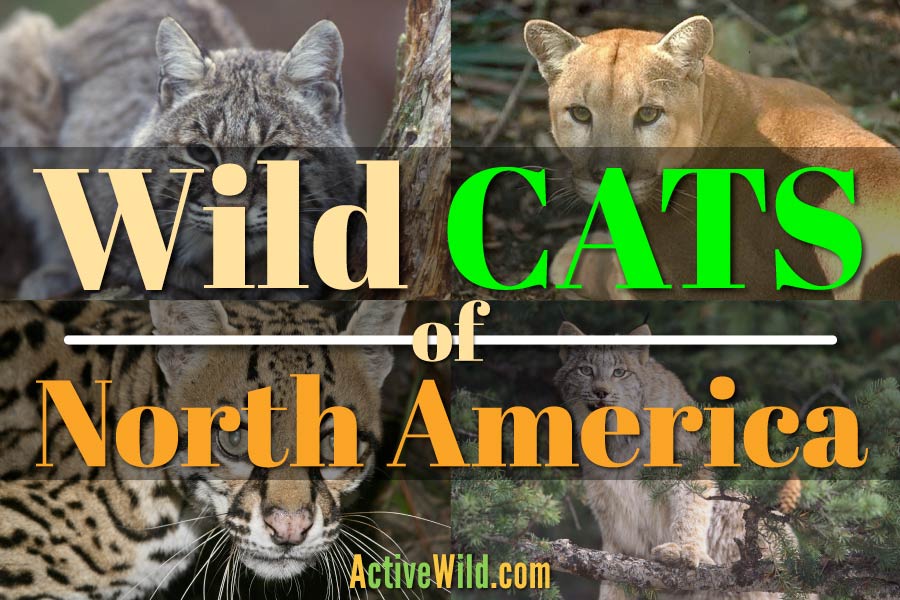

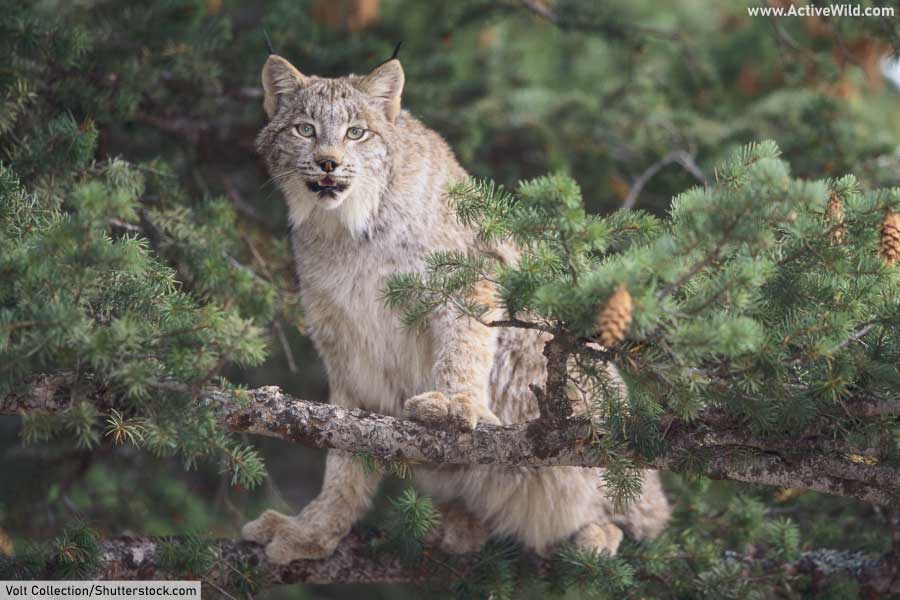
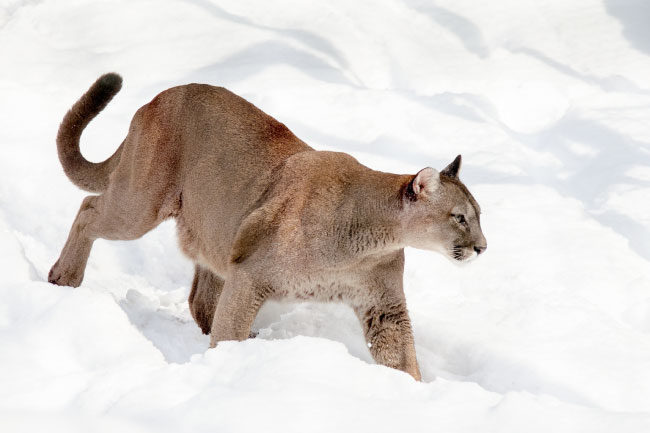
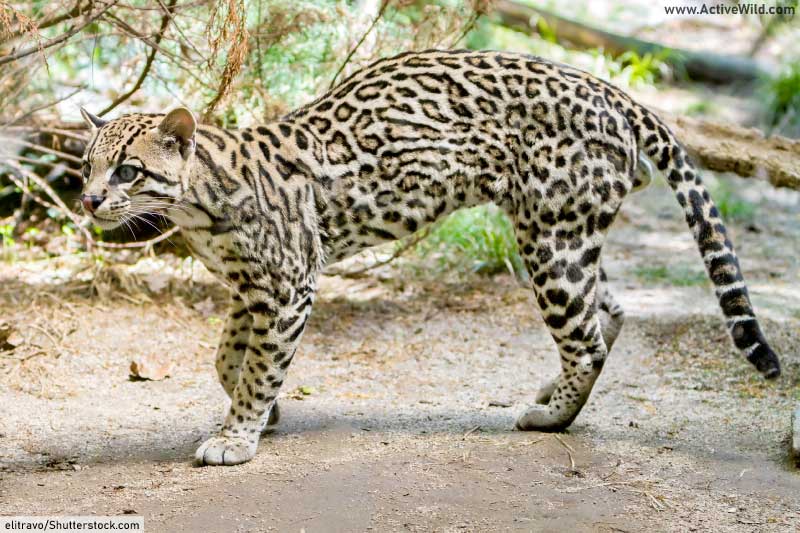
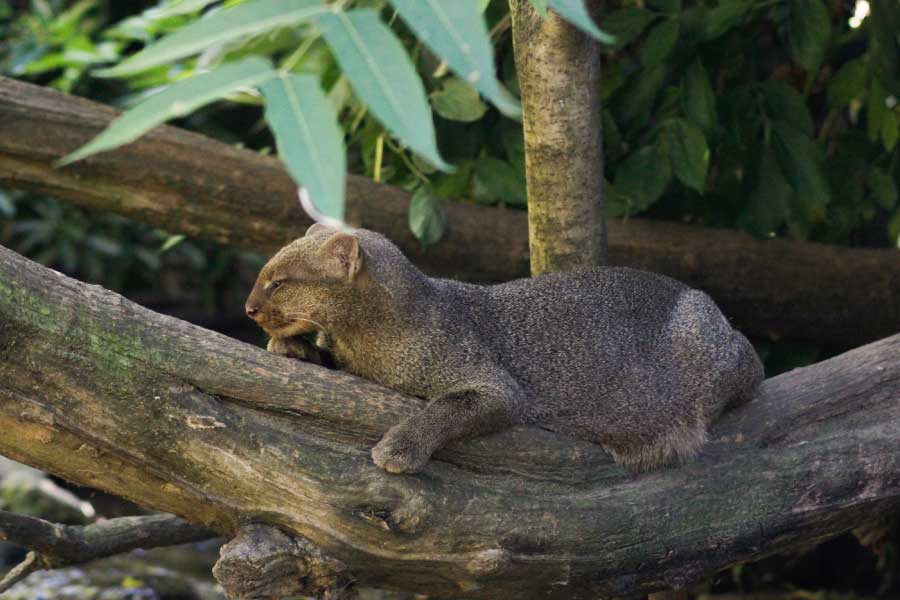

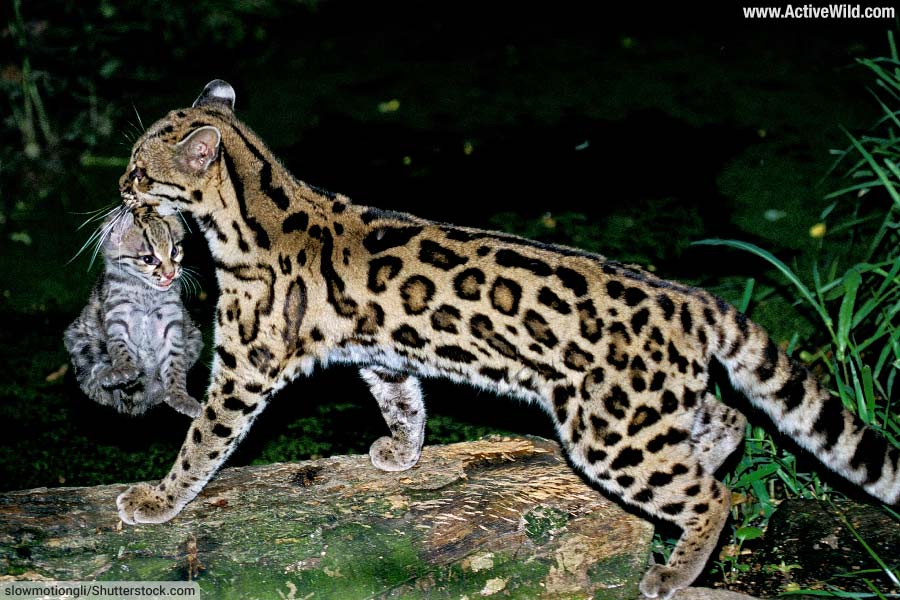

N.W. corner of Utah. Observed a large, dark catlike creature lurking around a marmot burrow under the side of a large building that is not in use. Late in the afternoon but still sunny out. Body much, much bigger than a house cat and shape blobby Very pointed ears on a head smaller than one would expect for its size.
Tail bristlely and twitched frequently. Definitely hunting. Moved around side of building and disappeared. There is a canal that runs up into the mountains in this area. I’m very familiar with mountain lions. This was smaller and definitely an adult. Any ideas?
Interesting. It sounds like a bobcat; was the tail quite short? Discounting mountain lions gives us very few other options, unless it was an extremely rare (for Utah) Canada lynx or a non-native escapee species. Hopefully you’ll get a better look at the animal at some point!
Thank you for your message,
The Active Wild Team.
I live in Southern Utah and just saw and heard the strangest thi g ever!! it was larger than a house cat smaller than a fox but made a noise kind of like a cougar but it looked to have rings on its tail??? any ideas? July 14th 2023. 440 am.
Hi,
Thank you for your message.
Unfortunately it’s very hard for us to identify species without a photo. In the case of wild cat sightings it often turns out that the animal was a larger than average house cat seen in poor light. Bobcats are fairly common in Utah but elusive – if the animal had a short tail then that’s probably what it was. Canada lynx are apparently present in Utah but extremely rare in the state. The only other wild cat found in Utah is the cougar / mountain lion, a much larger species.
Hopefully you’ll see the animal again and get a few more clues!
Regards,
The Active Wild Team
I live in North Central CT. on a hike today in a farm area that hikes up a wooded trail up a small mountain I saw a long-tailed cat that from a distance of about 50 yds.looked roughly the size of my foxhound mix. (She stands about 18″) I came around a bend and there it was.Not a coyote. No a bobcat or lynx. Definitely a long tail. Definitely a cat. Too big for most domestic types. Didn’t get a picture as I was trying to distract said foxhound. Coat seemed slightly darker than what I would call tan. Officially DEP says no mountain lions/cougars in CT, though there are many stories of sightings. Any thoughts?
Hi,
Thank you for your interesting comment. From your description, it sounds like a mountain lion, and we wouldn’t want to write that off completely. However, it would be highly unlikely; as you know, mountain lions are not officially present in Connecticut, and verified sightings are few and far between (the last confirmed sighting was, we believe, in 2011).
Perhaps if it’s an area local to you then you could ask around or even find somewhere to mount a camera trap?
If anyone else has any experience of mountain lions in CT then please let us know!
Regards,
The Active Wild Team
so, I found a kitten in TwentyninePalms area. Looks domestic by most standards. Blk & wht. But has an unusual face, doesn’t meow(makes a squeak that reminds me of a bobcat) and has very odd behaviors that I have never seen with any of my cats. I don’t live near anyone, so finding a kitten in the desert was quite shocking. Could he actually be a hybrid?
Hi,
Thank you for your comment. That’s an interesting question. The domestic cat has been known to hybridize with closely-related wild cat species (e.g. jungle cat and European wildcat, which both belong to the same genus, Felis, as the domestic cat), but such hybrids are extremely rare.
There are no confirmed domestic cat / bobcat hybrids (or hybrids of the domestic cat and any other North American wild cat) – the species are too different genetically to produce offspring.
We strongly suspect, therefore, that your cat is a domestic cat – perhaps its unusual behavior is due to a feral upbringing or its having been abandoned :(?
We hope this helps.
Regards,
The Active Wild Team
Saw one at a bar on east side Detroit.
funny!!
a short story… my Dr father traded a tractor for a ocelot… we had an not used quest house in the back yard do dad hearing that this cat was tamed :(even wore a chain and collar and you could walk it)just tossed him for the night into that one bed room guest house.. with a “threat to end your life” from dad not to go into the guest house… next day after informing the entire class, my best friend and I snuke and opened the back door (my best friend went first) into the kitchen… once barely in the door I look to my left and there this cat was perching… randy looked and before he could take his next breath this cat jumped him… belly into his face and all claws put and digging in… once mom came and got randy into car got er.
and the hospital gossip was a child has been attacked by a wild cat that was just the thrown into an abandoned house and left and it attacked a child by mask ng his entire upper body… dad was there at the er working and when we walked into that er my father almost stroked out and everybody rightfully so thought he was insane…
that night dad and I took the cat to the zoo….
my point is they might be on the small mid size but they can attacked and HURT YOU
That’s a great story, thank you for sharing!
The Active Wild Team
About 50 years ago I saw a Panther at Camp Strake (Boy Scouts) between Conroe and Huntsville, TX. It looked just like a cougar but with all black fur.
What about the Florida Panther?
Great question! The Florida panther is a mountain lion / puma found in Florida. This small population of mountain lions almost became extinct in the 60’s, but thanks to conservation efforts over 200 “Florida panthers” are now found in southern Florida.
Regards,
The Active Wild Team
Hey! I believe you. Nope it wasn’t a house cat was it?
I’m in South Georgia and I’ve seen one here. About 10 miles from Statesboro. Walked right up out of the swamp and looked at me At sundown. I could see him perfect. Huge. Size of a big dog.
You guys missed the Margay which lives in Southern Mexico. Still part of North America About “panthers”, there is no DNA of black pigmentation in Jaguars in North America. Follow reaserch done by UANL in Monterrey MX & Texas A&M Kingsville.
What about panthers? I’m from Alabama and I’ve seen them around rivers in Alabama
Good question. Strictly speaking, a panther is either a leopard or a jaguar with a mutation (known as melanism) that causes an excess of black pigment – giving the animal a black appearance.
Of those two species, only the jaguar is present in North America – but it is extremely rare in the US and, to our knowledge, not known in Alabama.
The mountain lion too is either extremely rare or non-existent in Alabama.
Therefore, the animal you saw may have simply been a large housecat, or perhaps a bobcat in low light.
There’s a (very) outside chance it was a jaguarundi – a species present in Florida, with occasional, and to our knowledge unverified, sightings in Alabama.
We hope this helps.
Regards,
The Active Wild Team
I live in huntsville texas and can confirm there are black panthers in the SE tx region.. one time i was fishing at huntsville state park and saw a BIG black cat within 30 feet of me had to be 200lbs i dropped my pole hollered and grabbed my pistol and i guess from me hollering i think i said xxxx xxxx or something and it took off running… another time i saw one near madisonville tx on hwy 21
I’ve seen videos online people have taken with what they say and appears to be a black panther! several others confirmed seeing the same thing in different southern states. so exciting!!
i saw a animal up on the ledge about 15 feet high in the evening this animal stayed stationary standing upright body brown ears small like a cat cougar 3 feet off the ground tail about 2 feet long head was wide dark tan to a light tan face went wide to narrow to its nose nose being black it was dark even with my outdoor lights on this creature was quite interesting did not move when i shined a light up around it the tail looked quite stiff i could not get a picture it was way up 15 feet above ledge.